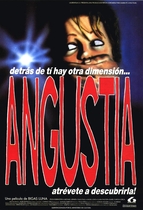Our editor-in-chief Nate Yapp is proud to have contributed to the new book Hidden Horror: A Celebration of 101 Underrated and Overlooked Fright Flicks, edited by Aaron Christensen. Another contributors include Anthony Timpone, B.J. Colangelo, Dave Alexander, Classic-Horror.com's own Robert C. Ring and John W. Bowen. Pick up a copy today from Amazon.com!
Deep Red (1975)
Deep Red (AKA Profundo Rosso), Dario Argento's 1975 uber-giallo is, more than any other film, the cornerstone of the director's work. Written with the help of Bernardino Zapponi, shot in vivid, hyper-real color, and scored with ear-rattling rock-and-roll, it is a thriller like none before and few since. Eschewing the dark sets and foggy streets that had been cliché since the silent era, Argento built upon the broad daylight and manicured production values of Hitchcock to establish a new idiom for the suspense film. Restored and released uncut by Anchor Bay, it is a film that deserves a place on the shelf of every horror and suspense film fan.
When British musician Marcus Daly (David Hemmings, Blow Up) witnesses a brutal murder in Rome, he becomes embroiled in the police investigation. Obsessed with the idea that he is forgetting some crucial detail, he risks becoming either the chief suspect or the next victim. Assisting him is Gianna (Daria Nicolodi in her first Argento film) as a gadfly reporter, and Calcabrini (Eros Pagni as an apoplectic police detective).
From these narrow plot threads, Argento weaves on of his best, and most imitated films. Deep Red is a stylish, stylized, and richly shot giallo. Motifs that wee only hinted at in his earlier films are now in full flower: the playful dialogue and relationships in The Bird with the Crystal Plumage, the stalking camera of Cat o' Nine Tails, the psychedelic colors of Four Flies on Gray Velvet. The identity of the killer is given away in such a clever way that no audience member ever sees it the first time, and never misses it on every subsequent viewing.
Argento is known as a visual director, and Deep Red is one of the two films that built that reputation. Shot in Technicolor, it is one of the most colorful, visually beautiful thrillers ever made. The screen is awash in the deep reds of the film's title. Not only does it spill from the murderer's victims, but the set design and the lighting is awash, as if never letting the viewer forget the bloody acts that are the heart if the films.
And what killings. While other filmmakers have surpassed Argento for graphic content, brutality, and cruelty, none have ever filmed such acts so viscerally. Compelled to stay attentive by the sheer, audacious beauty of it all, no audience member can watch and not feel the almost physical impact of the crimes. Shot cleanly, and well lit, the viewer feels like he himself is the victim. Or even the killer. Any person who can watch the teeth-on-the-fireplace scene without wincing is someone who belongs in a jail. Or an institution.
While justly famous as a visual stylist, Argento's scripts and his concern for dialogue is often maligned. In Deep Red, more than any other of his films, the reputation is belied. Deep Red is alive with personality. David Hemmings is terrific: low-key and bemused in his central role. Daria Nicolodi glows and sparkles, as Hemmings' greatest help and biggest challenge. And the secondary characters, from friend Carlo (Gabriele Lavia) and his off-kilter mother, to the detective Calcabrini, to the cast of eccentrics who make up the list of suspects, victims, and supporting players, are all written and acted with relish and personality.
Then there is the score. The driving, pulsing, pounding score by Italian rockers Goblin is as famous as the film itself, and even more influential. Deep Red established a sound for horror films that has lasted for over twenty years. Featuring short repeating motifs, stark dissonance, and a stomping rhythm section, it underscores the brutality on the screen with its own violence and deafening volume. Deep Red is a film meant to be played loud. Nearly everyone who has scored a horror film since, from Fabio Farrizi (Zombie and CIty of the Living Dead) to John Carpenter (Halloween) to Howard Shore (Shivers, Rabid and Videodrome in particular) has to list Goblin as a founding influence.
Deep Red marked the end of Argento's apprenticeship, and the beginning of his work as a master filmmaker. While he has tried his hand with equal success in more conventional horror films (Suspiria, Phenomena, Phantom of the Opera), it is to giallo that he continually returns. Each of his subsequent thrillers has built upon the framework laid down in Deep Red, in its own way remaking or re-inventing the conventions of the film. Tenebre, Opera, Trauma, and Sleepless are their own films, but each owes a debt to Deep Red that every fan will recognize.









Great review! I didn't see
Great review! I didn't see this one for a long time after seeing Suspiria, Phenomena, Opera and The Bird With the Crystal Plumage. I didn't realize what I was missing, as Deep Red is one of Argento's cruelest and most brooding giallos, and the best acted thanks to David Hemmings, Daria Nicolodi and Gabriele Lavia. (I do think the 126 minute version could use about 10 minutes shaved off it though.)
My suggestion is that you get
My suggestion is that you get Blue Underground's recent DVD & BluRay release of DEEP REDthat is the uncensoed American release version that has a running time of 105 minutes,eliminating the extra sequences of non violence and dialogue that made the original126 minutes version too long. The murder sequences areuncut in this 105 minutes version.